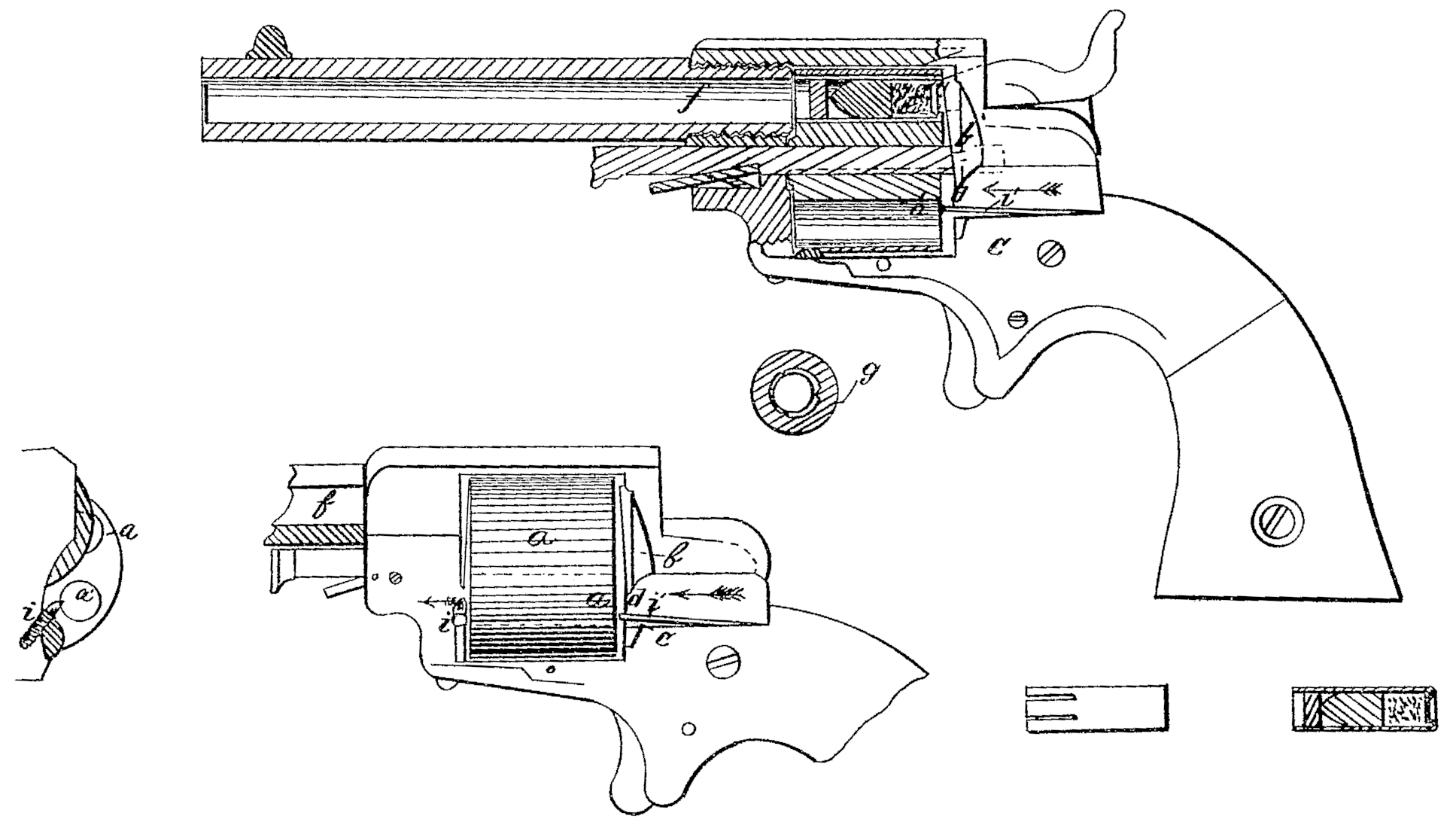US 34016
UNITED STATES PATENT OFFICE.
ANTHONY SMITH, OF HARTFORD, CONNECTICUT, ASSIGNOR TO HIMSELF AND WM. H. BRADLEY, OF SAME PLACE.
IMPROVEMENT IN REVOLVING FIRE-ARMS.
Specification forming part of Letters Patent No. 34,016, dated December 24, 1861,
To all whom it may concern:
Be it known that I, Anthony Smith, of Hartford, county of Hartford, and State of Connecticut, have invented a certain new and useful Improvement in Fire-Arms; and I do hereby declare that the same is described and represented in the following specification and drawings.
To enable others skilled in the art to make and use my improvement, I will proceed to describe its construction and operation, referring to the drawings, in which the same letters indicate like parts in each of the figures.
The nature of this improvement consists in the mode of inserting the cartridge into the back end of the movable chamber, and at the same time and by the same action ejecting the discharged cartridge or case therefrom, so that a continuous loading and discharge of the arm may be kept up without stopping to extract the case or to ram down the charge.
In the accompanying drawings is shown my improvement, (by an alteration in one of Ethan Allen’s arms, patented September 7 and November 9, 1858, and July 3, 1860,) in which a is the revolving cylinder. b is a collar formed on the frame-work c, just behind the cylinder a, and is about the same size or diameter therewith. d is an aperture cut in a proper manner in said collar, and in the frame-work, in line with one of the charge-chambers a’, so as to allow one of the cartridges to be laid therein and pushed forward into one of the chambers a’, said cartridges being made about the same length (longer or shorter) of the chambers a’, and are held in their proper place and not allowed to move either backward or forward by the action of the spring-stoppers i i’ (or their mechanical equivalent) until it is moved toward and in line with the barrel f of the arm, in readiness to be discharged.
It will be observed that the face of the collar b, just above the aperture d, is beveled on the inside, so that if the end of the cartridge is not pushed entirely into the chamber,even with the end thereof, the forward movement of the cylinder will force the cartridge home as the cartridge bears against the inside beveled face of the collar b.
It will also be observed that the rear end of the bore of the barrel f is slightly enlarged at its junction with the charge-chamber a’, (see g,) and that it is also provided with three points (more or less) protruding even with the bore and end of the barrel f to hold the cartridge-case back in its place in the chamber a’ before and while it is discharged, and at the same time allow of a free unobstructed passage of the charge from the cartridge-case into and through the barrel f.
Again, it will be seen that this improvement call be readily adapted to other arms now in use, and that with such adaptation thereto they will be rendered more valuable and formidable in the hands of the soldier or the sportsman, While at the same time it is more simple and cheaper of construction and can be loaded and discharged more rapidly; or, in other words, a continuous loading and discharging of the arm may be kept up without stopping to extract the case, as the discharged case is ejected by the act of inserting the charge.
In making this arm the style, form, and arrangement of parts may be varied according to the taste or fancy of the mechanic without altering or changing the mode described to produce the desired result.
By the use of this improvement I am enabled to load with one hand and fire with the other, and thus keep up almost a ceaseless discharge of the arm.
I believe I have thus shown the nature, construction, and operation of my arm, so as to enable a person skilled to make and use the same.
What I claim, therefore, and desire to secure by Letters Patent, is—
The improved method of ejecting the discharged cartridge by the simple act of inserting a fresh one in the rear thereof, substantially as herein described, by means of suitable depressions or openings of the frame or stock of the fire-arm, both in the rear and in front of the perforated cylinder, and in line therewith, the cartridge being held in place by the double retaining-springs i and i’, or their mechanical equivalents, substantially as shown, so that the said arm may be kept in constant readiness for firing by the single operation of continuous loading.
ANTHONY SMITH.
Witnesses:
Eugene. W. Greswold,
Jeremy W. Bliss.

